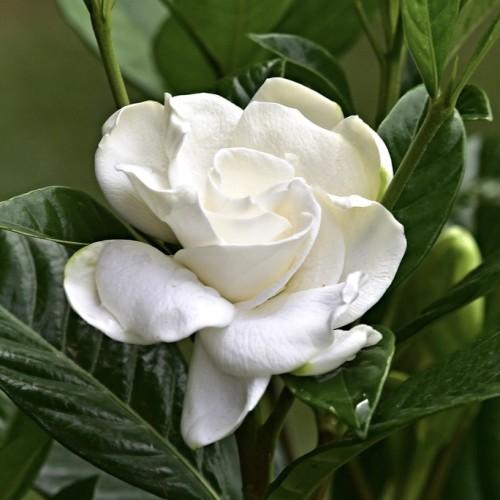
gardenia
Gardenia jasminoides
Cycle:
Perennial
Watering:
Frequent
Hardiness Zone:
8 - 11
Flowers:
Flowers In Spring
Sun:
part sun/part shade
Fruits:
Fruits Ready In Summer
Leaf:
Yes
Growth Rate:
Low
Maintenance:
High
Tropical:
Yes
Indoors:
Yes
Care Level:
Medium
watering
Gardenia plants should be watered when the soil surface begins to dry. Usually this means watering the plants about twice a week during spring and summer and once every 2 weeks during fall and winter. The amount of water depends on how much light the gardenia receives, soil type, and humidity. In general, you should water enough to moisten the soil to a depth of 8 to 10 inches. This can be accomplished by deep watering sessions that soak the root zone or more frequent, light waterings.
sunlight
Gardenia (Gardenia jasminoides) plants thrive in sunny locations, but should be protected from direct sun during the hottest hours of the day, usually between 10 a.m. and 3 p.m. The ideal sunlight for Gardenias is 4 to 6 hours of morning sun, followed by afternoon shade. Morning sun will help the plants set blooms and develop tighter, darker green foliage. Too much sun can dry out the soil and cause leaf scorch and sunburn on the foliage.
pruning
Gardenia jasminoides plants should be pruned twice a year—in late winter and midsummer—for maintenance purposes. In late winter, remove any dead or diseased branches and lightly trim the shrub to maintain its shape and size. In midsummer, gardenias can be pruned for a more aggressive shape with a skinnier profile than the natural round shape. If desired, small, branch-like cuts can be made to encourage branching out. Always use sharp, sterile pruners or shears and sterilize the blades between cuts by dipping them in rubbing alcohol and wiping them with a clean cloth.
Propagation
Season
Hardiness Map
FAQ
Is the gardenia plant suitable for indoor or outdoor growing?
Gardenia plants are best suited for outdoor growing with morning sunshine and afternoon shade. They thrive in tropical and warm subtropical climates with frequent watering and well-draining soil. Those living in colder climates can grow gardenia indoors, but will require lots of extra care and attention. Plant your gardenia near a sunny, south-facing window to ensure plenty of light and consistent temperatures above 65F. A south-west-facing window is best, with east and west-facing windows as a secondary option. You should water your gardenia daily while maintaining humidity levels as high as possible.
Are gardenias tolerant of cold temperatures?
No; gardenias are not tolerant of cold temperatures. Gardenias need temperatures between 65-75°F (18-23°C) and will not survive temperatures that drop below freezing. Additionally, they should be protected from prolonged exposure to wind and rain, which can damage the sensitive leaves and flowers. If the temperatures in your area drop below 45°F (7°C), it is best to bring the gardenia indoors to protect it.
Should gardenias be planted in a particular season?
Gardenias should be planted in the early spring or late fall season when temperatures are mild. Gardenias prefer cooler temperatures for optimal growth and prefer to be planted in well-drained soil. In addition, they need to be planted in a spot that receives ample bright sunlight but is shielded from direct midday and afternoon sunlight. Finally, during the summer months, they need to be watered regularly and fertilized every two weeks.
Could gardenias be grown in containers?
Yes, gardenias can be successfully grown in containers! Container gardening is perfect for areas with limited space, or as an easy way to move the plants around to areas with more or less sunlight. When growing gardenias in containers, make sure to use a large one, close to 20 inches in diameter, with drainage holes and filled with potting mix. The container should be placed near a window that gets some direct sun, but it should also be protected from the wind. Deep waterings will be necessary in extremely hot, dry periods. Feed container gardenias every few weeks with a balanced fertilizer to encourage blooms. All in all, container gardening is a great way to enjoy gardenias, even if there's limited space.
Are gardenias self-pollinating?
No, gardenias are not self-pollinating. Gardenias require assistance from pollinators like bees to transport pollen from the male parts of one gardenia flower to the female parts of another. Without this help, it would be hard for some gardenia varieties to produce seed and fruit. As such, it is important that gardeners ensure their gardenia plants are in close proximity to bee-friendly flowers such as lavender for the best pollination and fruit yield.
Could gardenias be propagated from cuttings?
Yes, gardenias can be propagated from cuttings. This is typically done in late summer or fall when the new growth on gardenias has hardened off. Using a clean, sharp knife, cut 6-inch tip cuttings from the current season’s new growth. Remove any flowers and leaves from the lower half of the cuttings. Dip the cuttings in a rooting hormone then plant in a container filled with a soil-less potting mix. Care for the cuttings by providing indirect light and occasional misting. After a few months, you should be able to see signs of new growth and can then transplant your gardenia cuttings into a permanent location.
Are gardenias commonly used in landscaping?
Gardenias are beautiful flowering plants often used to line walkways and garden beds in landscaping designs. Gardenias produce white, fragrant flowers in the summer that attract pollinators and give a lovely fragrance in the garden. Gardenias are also deer and rabbit resistant, which makes them ideal for natural or low-maintenance landscaping where you'd like to control the wildlife. Lastly, gardenias are easy to care for, requiring regular watering and full sun or partial shade to thrive. Because of these characteristics, gardenias are quite often used in landscaping.
